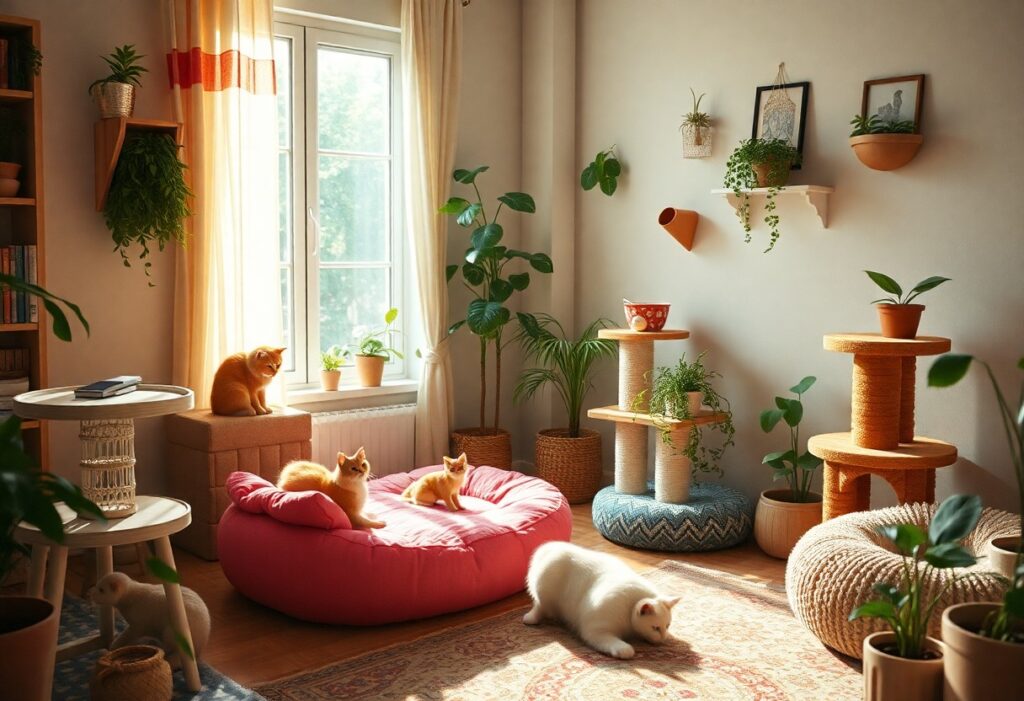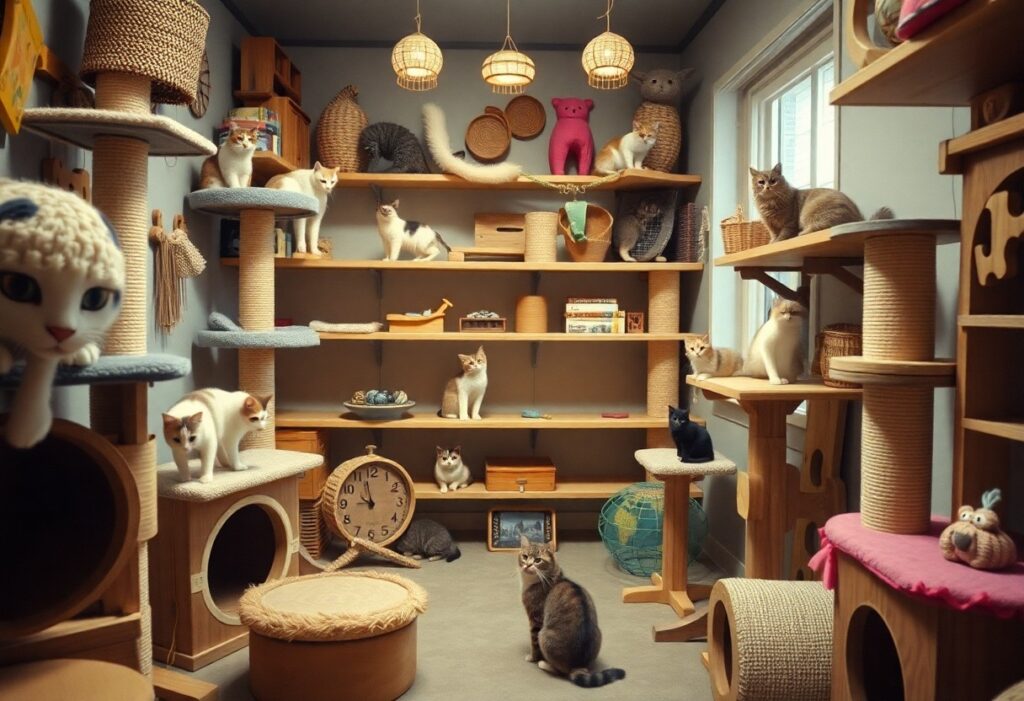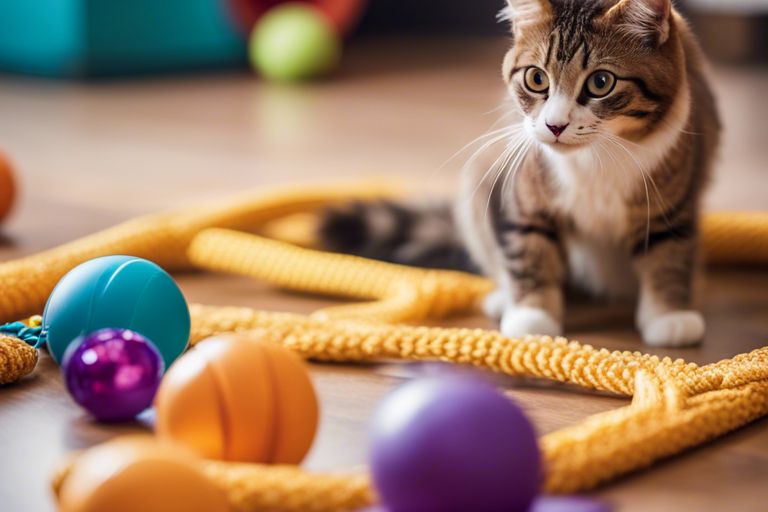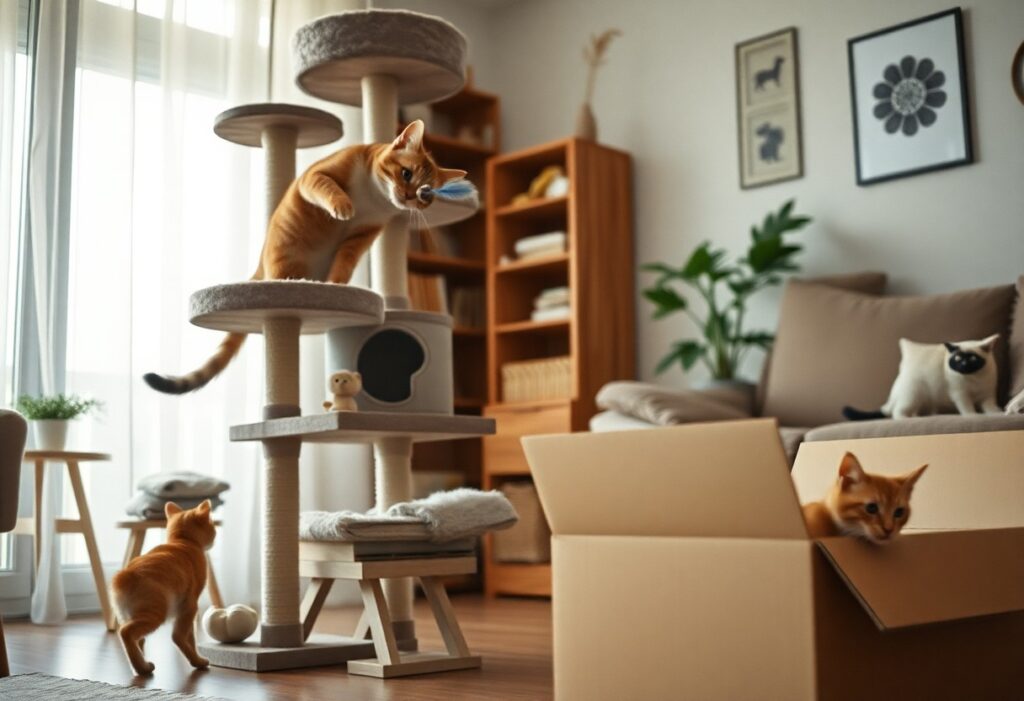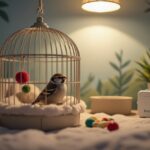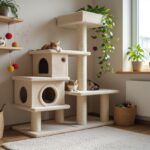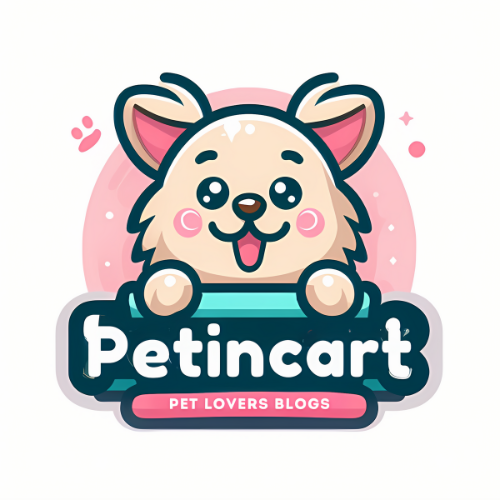Just as humans thrive in vibrant environments, your cat will flourish in a thoughtfully designed indoor space that caters to their natural instincts. By incorporating elements that promote play, exploration, and comfort, you can create a stimulating atmosphere that keeps your feline friend physically active and mentally engaged. From interactive toys to cozy nooks and vertical spaces, this guide will show you how to transform your home into an enriching sanctuary that brings joy and happiness to your furry companion.
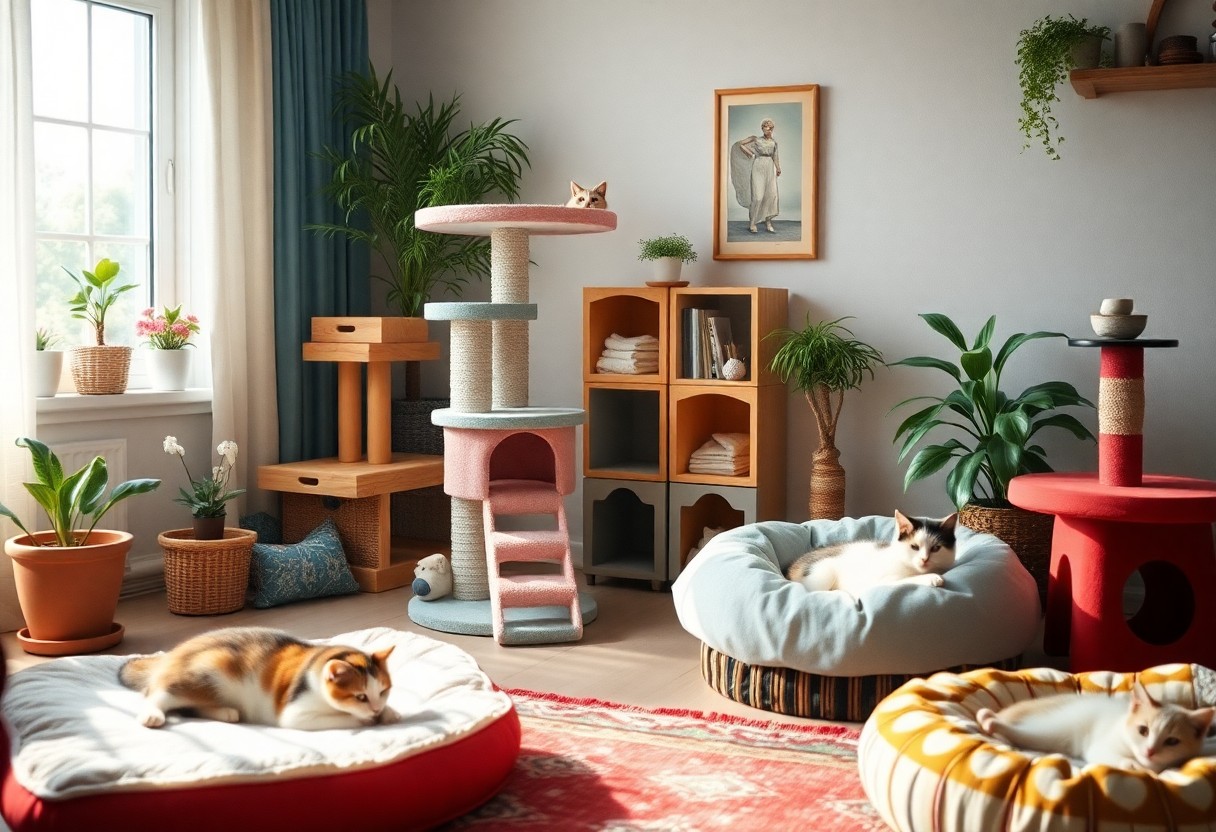
Key Takeaways:
- Incorporate vertical spaces such as cat trees, shelves, and window perches to encourage climbing and exploration.
- Provide a variety of engaging toys and puzzle feeders to stimulate mental activity and prevent boredom.
- Create safe hiding spots and cozy napping areas where your cat can feel secure and relaxed.
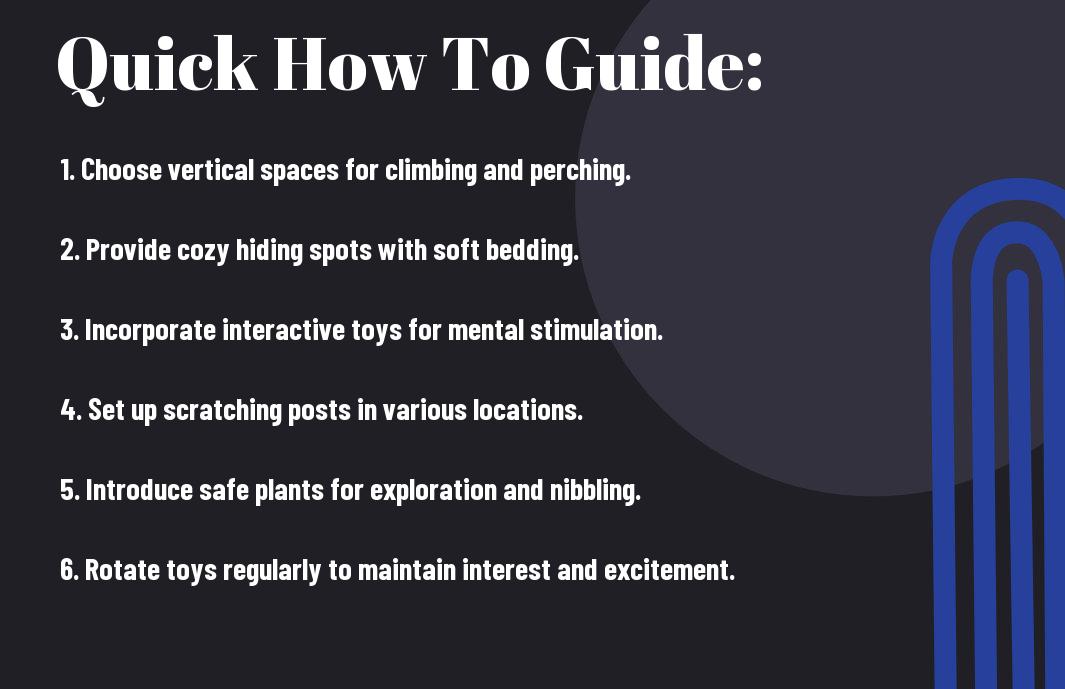
Understanding Your Cat’s Needs
The well-being of your feline friend depends significantly on understanding their unique needs. Cats are naturally curious and require an environment that stimulates their instincts for exploration, hunting, and climbing. By recognizing their behavioral patterns and preferences, you’ll be better equipped to create a fulfilling indoor living space that fosters their happiness and reduces stress. Simply put, a happy cat is a healthy cat.
Factors Affecting Indoor Happiness
Your cat’s happiness can be influenced by several key factors:
- Social interactions – ensuring plenty of quality time with you
- Play opportunities – providing a variety of toys and activities
- Environmental enrichment – incorporating elements like climbing shelves and scratching posts
- Routine and security – maintaining a stable environment
After considering these factors, you’ll be better positioned to support your cat’s emotional needs.
Importance of Space and Environment
Indoor environments play a significant role in your cat’s overall happiness. A well-designed space helps meet their physical and mental stimulations, which are important for a fulfilled life. The inclusion of vertical spaces, such as shelves and cat trees, allows them to exercise their climbing instincts while providing a sense of security. Additionally, offering a mix of hiding spots and open areas can help them feel both secure and enriched. Ensure their environment is safe by removing any hazardous items. When you balance these elements thoughtfully, you’ll create an inviting area that supports your cat’s natural behaviors and contributes positively to their well-being.
Creating Vertical Spaces
If you want to enrich your indoor spaces for a happy cat, consider creating vertical spaces. Cats are natural climbers and enjoy perching high above ground. Incorporating elements like cat trees, shelves, and wall-mounted play areas will provide your feline friend with the stimulation they crave while also enhancing your home’s aesthetic.
Tips for Cat Trees and Shelves
You can optimize your cat’s enjoyment by following these tips for selecting cat trees and shelves:
- Choose sturdy furniture that can withstand your cat’s weight.
- Incorporate ramps and steps for easier access.
- Provide scratching surfaces for added appeal.
- Use multiple levels to encourage exploration.
After implementing these tips, your cat will have a delightful playground to explore.
Safe Access to High Perches
If you want your cat to reach high perches safely, it’s vital to design spaces with their safety in mind. Ensure they have adequate support when navigating heights, and avoid slippery surfaces that could lead to falls. Incorporate climbing structures, such as cat trees with built-in steps, to facilitate a safe ascent. Also, consider using wall shelves with a wide base and secure fittings to avoid wobbling when your cat jumps.
It’s vital to create a comfortable environment that allows your cat to feel secure while accessing higher perches. This includes providing soft landing areas and ensuring the heights are suitable for their size. Avoid using furniture that could tip over, and regularly check that ropes or climbing aids are in good condition to prevent accidents.
Engaging Your Cat with Play
Unlike dogs, who often seek human companionship for fun, your cat may prefer to initiate playtime on its own terms. By understanding your cat’s unique play style, you can create a stimulating environment that keeps them active and entertained. Regular playtime isn’t just about fun; it also engages their hunting instincts, boosts mental stimulation, and strengthens your bond with them.
Types of Interactive Toys
To keep your feline friend entertained, consider incorporating a variety of toys into their play routine:
| Wand toys | Prompt natural hunting instincts |
| Laser pointers | Engage your cat in fast-paced chases |
| Feather toys | Mimic the movement of birds |
| Automated toys | Encourage solo play |
| Puzzle feeders | Stimulate your cat’s problem-solving abilities |
Perceiving the variety of toys available can help you select the ones that best suit your cat’s playful personality.
Benefits of Regular Playtime
An enriching play session offers your cat numerous benefits, including physical exercise and mental stimulation. Engaging your feline friend in play can help reduce stress and prevent behavioral issues related to boredom. Additionally, regular play not only keeps your cat in shape but also strengthens the bond you share.
Plus, incorporating regular playtime into your cat’s daily routine can prevent obesity, encourage healthy habits, and reduce anxiety. When your cat is engaged, they are less likely to develop disruptive behaviors stemming from boredom. An investment in play is an investment in your cat’s overall well-being, keeping them happy and healthy.
Providing Comfort Zones
Not only do cats crave adventure, but they also require areas that offer tranquility and comfort. Creating designated comfort zones in your home helps your feline friend recharge, fostering a happier environment. Focus on spaces that feel inviting and secure, as this aids in your cat’s emotional well-being.
Cozy Beds and Hideaways
If you want to pamper your cat, investing in cozy beds and hideaways is imperative. Look for soft, well-padded beds that cater to your cat’s preferences, whether they prefer enclosed spaces or open-style lounging. Placing these beds in quiet areas away from busy household activities will provide them a perfect retreat.
Importance of Safe Spaces
Providing safe spaces for your cat significantly reduces stress and promotes mental health. Cats are instinctively drawn to places where they can feel hidden and secure, which helps them effectively manage feelings of anxiety. By creating designated safe zones, such as high perches or enclosed hideaways, you contribute to their overall wellbeing and peace of mind.
Importance of safe spaces cannot be overstated—for your cat’s emotional health is intertwined with their environment. When your feline has access to retreats where they feel shielded from disturbances, they’ll be less likely to exhibit stressful behaviors, such as hiding or aggression. Furthermore, providing these areas encourages your cat to engage in natural behaviors, giving them the freedom to explore at their own pace. Bolstering both their physical and emotional health, safe spaces enhance your bond with your cat, creating a harmonious home atmosphere.
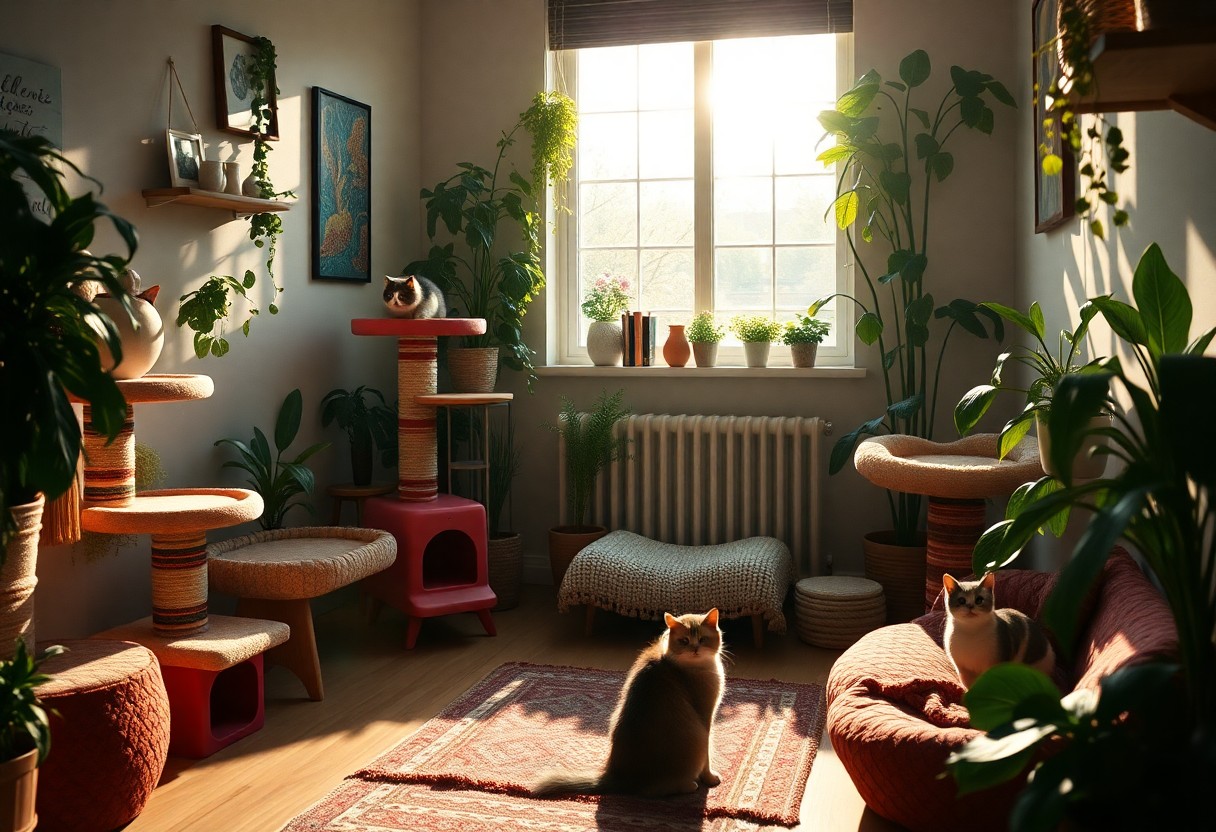
Enriching the Environment
All cats thrive in well-designed spaces that stimulate their senses and encourage natural behaviors. To create an enriching environment for your feline friend, it’s important to incorporate various elements that promote exploration, play, and relaxation. From multi-level structures to cozy napping spots, tailor your home to provide your cat with options that cater to their instincts and preferences, ultimately enhancing their overall well-being.
Incorporating Natural Elements
While bringing the outdoors in may seem challenging, incorporating natural elements into your home can significantly enrich your cat’s environment. Consider adding cat-safe plants or a small indoor herb garden, which not only beautify your space but also offer sensory stimulation. You might also want to include elements like wood, sisal, or bamboo in toys or scratching posts to replicate textures found in nature.
Sensory Enrichment Ideas
Assuming you want to provide stimulating activities for your cat, consider various sensory enrichment ideas that can keep them engaged and happy. These can include important smells for felines, such as catnip or silver vine, and interactive toys that require mental stimulation. You can also create scavenger hunts using food puzzles, allowing your cat to use their sense of smell and problem-solving skills.
The best form of sensory enrichment involves a mix of visual, tactile, and olfactory stimuli that cater to your cat’s instincts. Incorporate a variety of toys, from feather wands to balls with bells, to provide engaging playtime. Don’t forget to introduce different textures through various materials in toys and surfaces in your home, and employ tasteful treats as rewards during interactive play. Always ensure that the items you choose are safe and non-toxic to avoid any health concerns, prioritizing your feline companion’s happiness and safety.
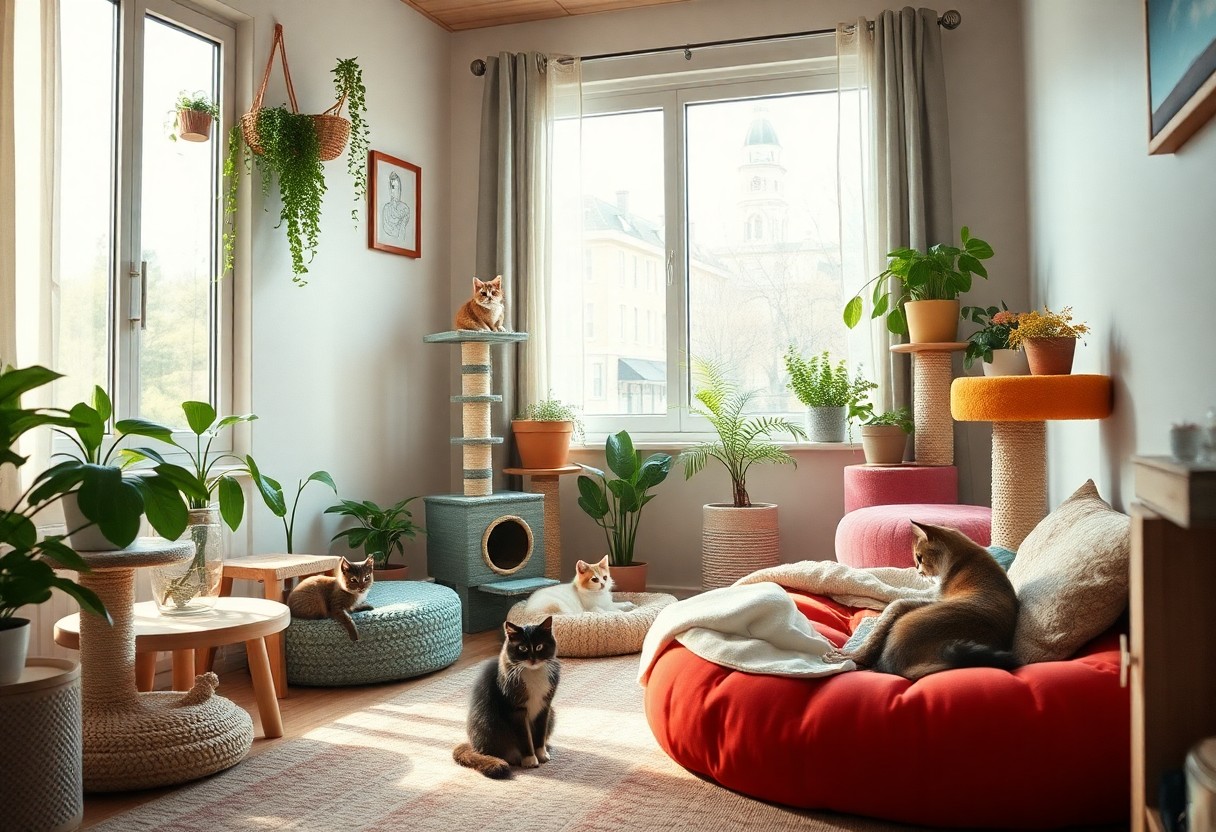
Social Interaction and Stimulation
Now that you’ve set up an enriching environment for your cat, it’s imperative to incorporate social interaction and mental stimulation into their daily routine. Cats are social creatures, and engaging them through play and companionship will not only boost their happiness but also strengthen your bond. Simple activities, such as interactive play or even just talking to them throughout the day, can keep your feline friend mentally active and content.
Introducing Companionship
Little changes can make a big difference when it comes to introducing companionship to your cat’s life. Consider adopting a second cat, or providing opportunities for playdates with friendly felines. Just ensure that the new companion matches your current cat’s temperament and social needs, so their time together remains positive and enriching.
Understanding Playtime Boundaries
For a fulfilling and safe playtime experience, it’s important to establish and respect playtime boundaries with your cat. Recognizing when your cat wants to play versus when they need a break will help prevent overstimulation or frustration, ensuring your time together is enjoyable. Pay attention to their body language for signs of discomfort and adjust the play accordingly.
Companionship plays an imperative role in your cat’s happiness, but understanding their limits during playtime is equally important. Cats will often show signs of agitation, such as swatting, hissing, or fleeing when they’ve had enough. Establishing boundaries helps create a safe space for your cat, enhancing their willingness to engage while also allowing them to feel secure. By adopting a mindful approach to play, you will foster a trusting relationship, making your indoor space not just a home, but a sanctuary where they feel safe and loved.
Conclusion
On the whole, creating an enriching indoor environment for your cat involves understanding their natural instincts and preferences. By providing vertical spaces, interactive toys, and cozy resting areas, you significantly enhance their quality of life. Incorporating sensory stimulation through scents and textures while allowing them to explore their surroundings will keep your cat engaged and content. Ultimately, a thoughtfully designed space will foster your cat’s well-being and happiness, making your home a haven for your feline friend.
FAQ
Q: What are the crucial elements for creating an enriching indoor space for my cat?
A: To create an enriching indoor environment for your cat, it is important to include various elements such as vertical spaces (like cat trees or shelves), interactive toys, scratching posts, and cozy hiding spots. Additionally, incorporating elements like window perches for bird-watching can provide mental stimulation. Ensure a variety of textures and surfaces are available for exploration and encourage play and exercise.
Q: How can I encourage my cat to play and be more active indoors?
A: To promote play and activity in your cat, try using a variety of toys—like feather toys, laser pointers, and interactive puzzles—to engage their instincts. Rotate the toys regularly to maintain their interest. Scheduled playtime is also beneficial, as it establishes a routine and provides an opportunity for bonding. Consider setting up obstacle courses or allowing your cat to explore new areas of your home safely to spark their curiosity.
Q: Is it important to have multiple cats in the household for effective indoor enrichment?
A: While having multiple cats can enhance social interaction and provide companionship, it is not a requirement for enriching indoor spaces. Single cats can thrive in stimulating environments where their needs for play, exploration, and personal space are met. Providing diverse activities, toys, and scratching options can significantly enhance a solo cat’s quality of life.
Q: How can I ensure my indoor cat has access to natural light and fresh air?
A: To provide your cat with access to natural light and fresh air, consider placing their resting areas near windows or using window perches. Screened balconies can also allow for safe outdoor exposure. Creating a cat-friendly window area with a comfortable spot to relax can let them enjoy the sights and sounds outside without leaving the safety of your home.
Q: What types of plants are safe for indoor cats, and how can I incorporate them into the space?
A: Safe plants for indoor cats include cat grass, catnip, spider plants, and certain types of herbs like parsley and basil. These can be incorporated into your cat’s environment by placing them in areas that are easily accessible. Use plant stands or pots that are stable and won’t tip over easily. However, always research plant safety to ensure any additions to your home won’t harm your feline friend.
